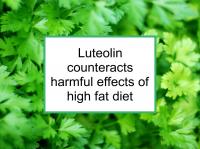Luteolin is a yellow pigment found in a variety of vegetables but is especially concentrated in celery seed, Mexican oregano (Lippia graveolens), thyme and radicchio. Significant levels of luteolin are also found in parsley, hot peppers, artichokes, mint and sage, as well as some other culinary herbs.
Diets high in luteolin have been found to be associated with reduced risk of breast cancer. Now a new study has reported that luteolin suppresses mouse mammary tumor formation and growth even in the presence of a high fat diet.
Anti-breast cancer effects of luteolin
Luteolin has been found to cause a decrease in breast cancer cell viability in a dose-dependent and time-dependent manner. Luteolin has also been shown to inhibit angiogenesis (new blood vessel formation), the production of estrogen by ovarian cells, and aromatase activity (a process by which androgens are converted to estrogens in the body).
In addition, luteolin has been shown to induce apoptosis (programmed cell death) and reduce proliferation in multidrug resistant hormone receptor positive (ER+/PR+) breast cancer cells. In fact, luteolin has been shown increase the anti-cancer effects of the chemotherapy drugs doxorubicin and paclitaxel, as well as overcoming tamoxifen resistance in tamoxifen-resistant breast cancer cells, thereby improving its treatment effects.
Luteolin-rich foods are a better choice for breast cancer patients and survivors than luteolin supplements. Safe and effective levels of luteolin have not been established. Luteolin is a phytoestrogen, which means that it has the potential to have both breast cancer promoting and inhibiting effects, depending on dosage and other factors. One study has suggested that luteolin could promote endometrial cancer (which is already a possible side effect of tamoxifen treatment).
Latest research finds luteolin inhibits tumors in low- & high-fat diets
The study referenced at the beginning of this news article was designed to examine the effects of luteolin supplementation on mammary tumor growth in mice fed either a high-fat (with fat comprising 45% calories) or low-fat diet (15%). Mice were divided into four groups of 12, which were then assigned to (1) a low-fat diet without luteolin supplementation; (2) a low-fat diet plus luteolin supplementation; (3) a high-fat diet without luteolin supplementation; or (4) a high-fat diet plus luteolin supplementation. A carcinogen was administered to induce mammary tumors.
Mice in the low-fat plus luteolin group were found to have longer time to tumor development and lower tumor mass than the other three groups. Mice in the high-fat, no luteolin group had elevated insulin-like growth factor 1 (IGF-1) levels and increased mammary tissue expression of Ki-67 (a measure of proliferation), insulin receptor substrate 1 (IRS-1), as well as pp38, Cdk4, and Cdk6 (proteins encoded by cancer-associated genes). On the other hand, the addition of luteolin to the high-fat diet inhibited IRS-1, Cdk4, and Cdk6 expression. Luteolin reduced the expression of pp38, cyclinD1, and Bcl-xL (also encoded by cancer-associated genes) in both the low-fat and high-fat groups. The authors conclude that luteolin suppresses mammary tumor formation in the presence of both low-fat and high-fat diets.
